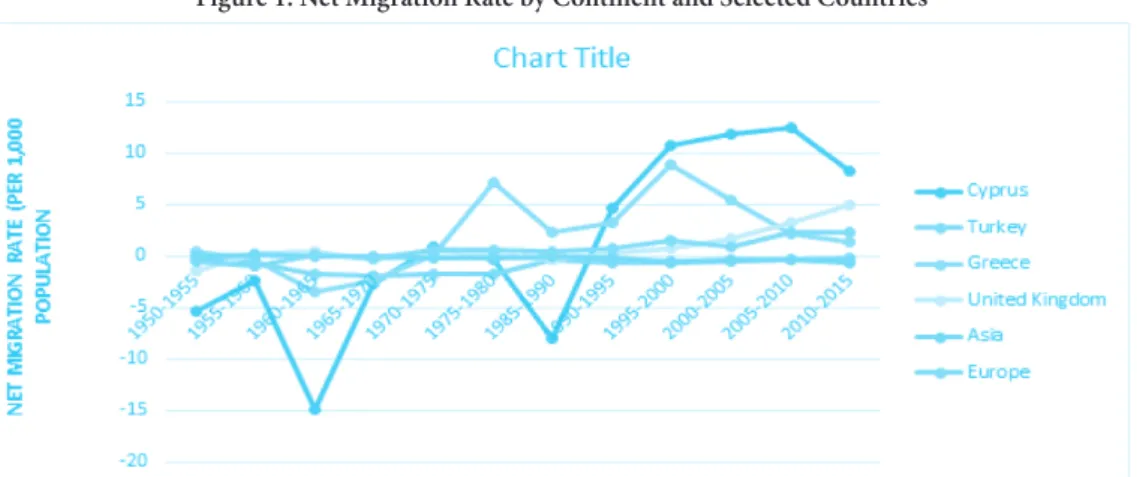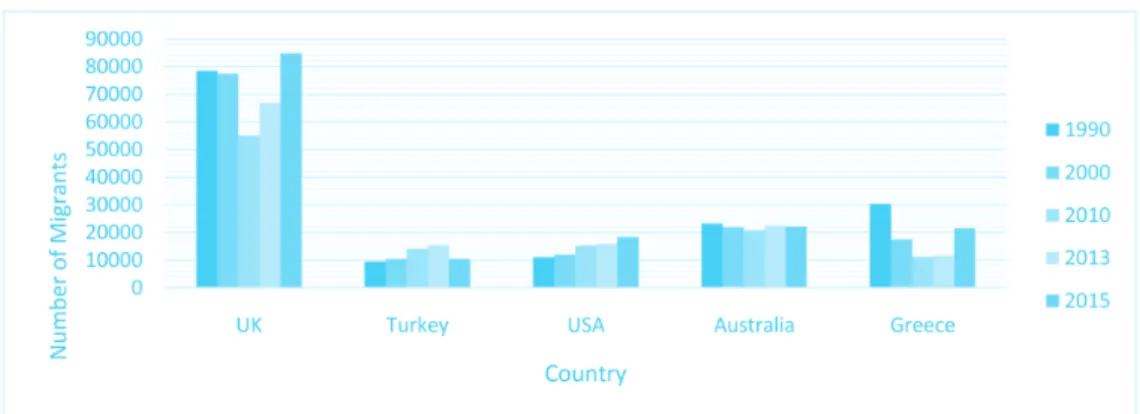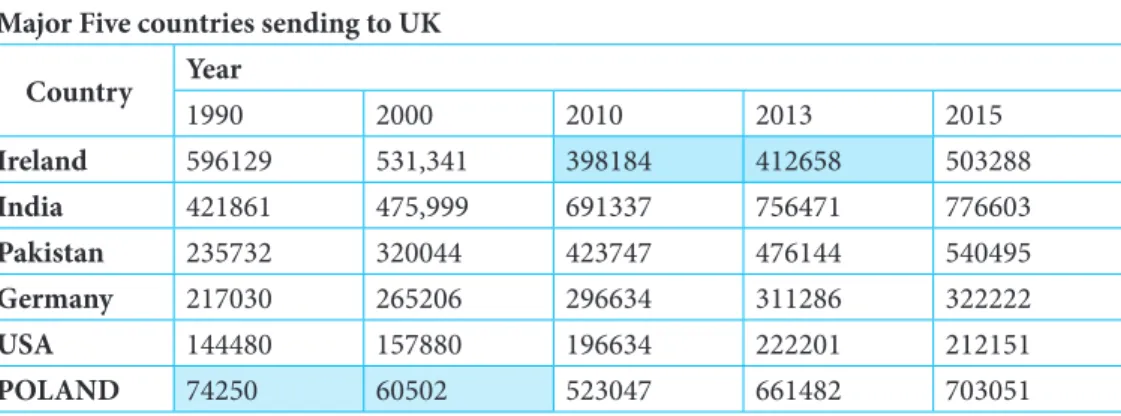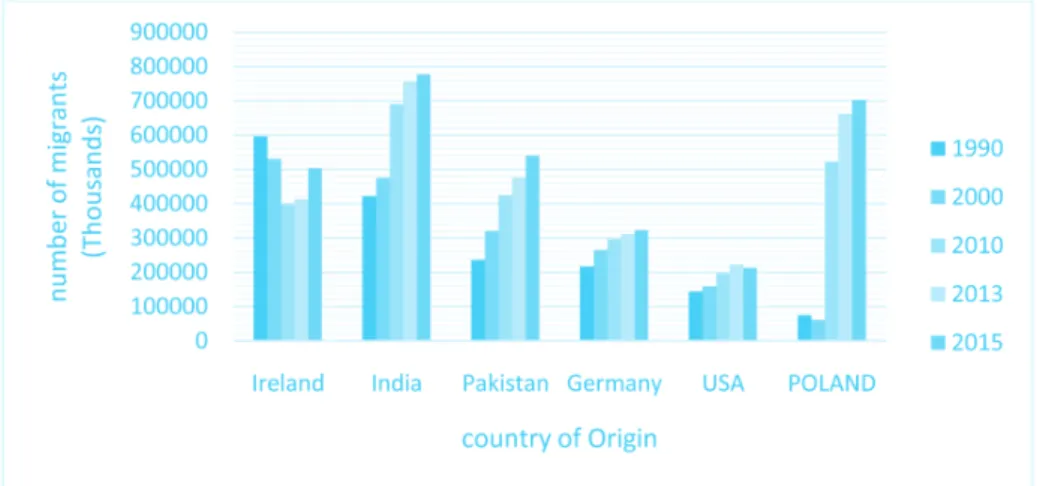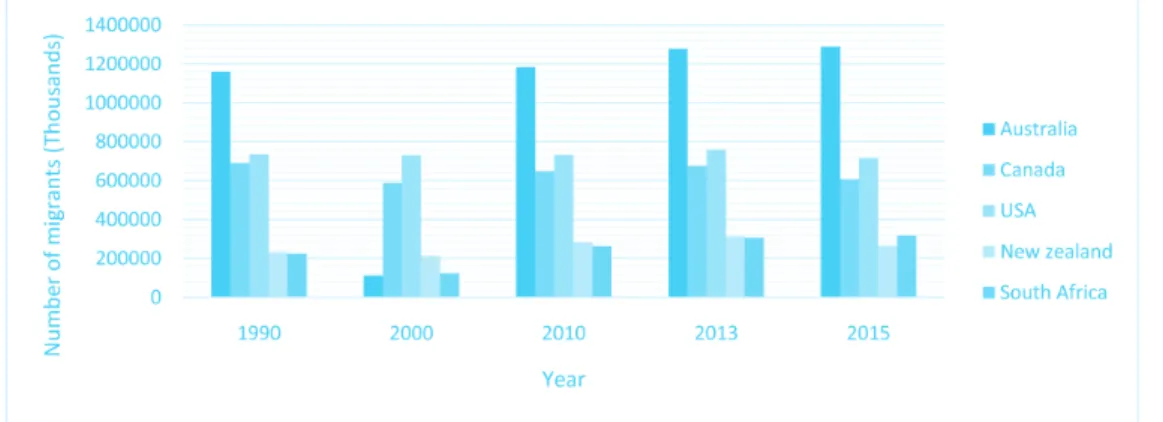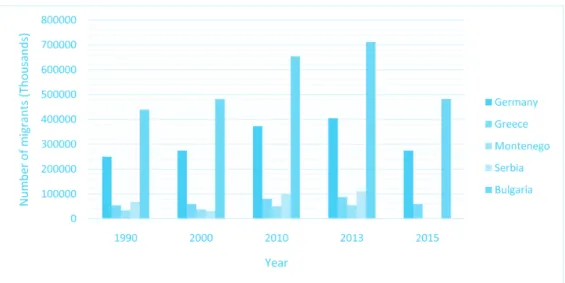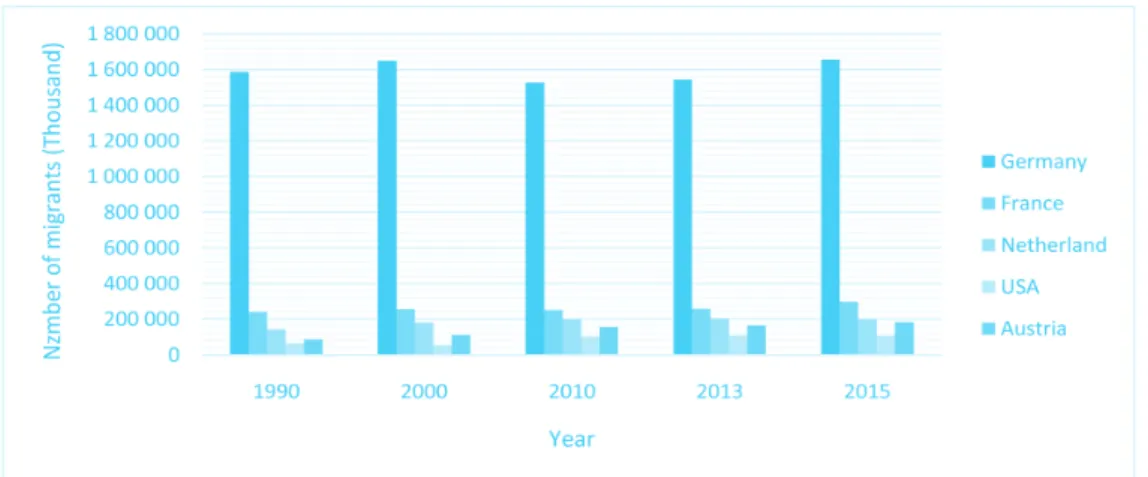Tilek Bakytbekov
1Migratory Links between Cyprus, Turkey, Greece and Great Britain between 1990-2015
This study tried to investigate the migratory linked between Cyprus, UK Turkey and Greece.
The focus was Cyprus because the country is known for its ethnic conflicts since the Turkish invasion in 1974 and the collapse of the republic of Cyprus which lead to migration of Cyprus people to UK, Turkey and Greece. The migration from Cyprus to UK was mainly the result of their Colonial ties and to turkey and Greece because most of them are ethnical Greeks and Turkish. The number of female migrants from and to UK were more than that of male.
1. Introduction
Migration is the movement of people from one region or country to another. Migration in Latin "turn", "resettle" is the movement of people across borders of certain territories associated usually with a change of residence. There is no legally agreed definition, but the UN defines a migrant as a person living in a foreign country for more than one year, regardless of the reasons for migration voluntary or involuntary and migration methods legal or illegal. Migration has many centuries of history, and for the past two hundred years, there is a free mass migration that is the movement of people that are not coerced, like slaves and contract workers. The reasons for this movement do not constitute a big secret: today, as well as two hundred years ago, people strive to improve their lives.
The reasons for the economic nature lie in the different economic level of development of individual countries. Labor moves from countries with a low standard of living to countries with the highest level. Objectively, the possibility of migration appears due to national differences in the conditions of wages for a particular professional activity.
Social reasons include the desire to change status and lifestyle. This, for example, is moving from a village to a big city, joining foreign university. Immigration through training is one of the most common ways to change your country of residence. This also includes family reunification, moving to the future spouse's place of residence.
Cultural reasons encourage believers to make annual pilgrimages to holy sites, and re-emig- rants return to where their ancestors used to live.
Political migrants and refugees are being persecuted and repressed at home for their beliefs.
In general, the factors influencing the process can be divided into attracting and pushing. They go either to something good, or from something bad. Pushes include armed conflicts, wars, and environmental disasters. People in such cases simply have no choice and are forced to move to another country.
So, one of the reasons for migration is armed conflicts, wars, and Political instability. That’s why the author chose Cyprus as there is unresolved ethnic conflict since 1974 till present that has been argued to cause migration. In this paper, the author would like to explore what factors
1 PhD Student, International Relations Multidisciplinary Doctoral School, Corvinus University of Budapest DOI: 10.14267/RETP2019.03.22
caused people from Cyprus to migrate to other destinations? Based on this question we can un- derstand how strong the influences of Cyprus conflict for growing up or rising up the amount of migrates from Cyprus to other destinations. Author chose Greece, Turkey and Great Britain to examine migrants flow from Cyprus, because more than half of the Cyprus populations are ethnically Greek and ethnically Turk Cypriots, which is directly relate to Turkey and Greece.
2. Net Migration and Historical Development in Cyprus, Turkey, Greece and United Kingdom
Cyprus is the third largest island of the Mediterranean Sea and is located in the Far Eastern part of the sea, historically adjacent to Europe, Asia and Africa. It became an independent republic in 1960 after a turbulent history. In post-colonial times, there was inter-communal strife and cons- tant foreign intervention of one kind or another, until 1974 when a coup by the Greek junta and local para-fascists, the EOKA, was used as a pretext for the Turkish invasion and the subsequent division of the island. [Hitchens 1997; Attalides 1979]. Turkey still occupies 34% of the territory, whilst 200,000 remain Greek refugees and the Turkish Cypriots remain in the north which is occupied by Turkey. Attempts to resolve the Cyprus ethnic conflict have not been successful for over twenty years. Cypriot policy makers now hope that the policy of accession to the EU would act as a catalyst in the effort to find a settlement. [Kranidiotis, 1993]. After Greek junta coup and the Turkish invasion of 1974, which left the society and economy devastated: an 18 % fall of the GNP between 1973 to 1975, a 30% rise in unemployment, mass poverty and a loss of 37% of the country’s territory, Cyprus has seen extensive economic development (PIO 1997b). It has been transformed into a society which acts as „host” to immigrants, from different countries, who occupy a range employment positions, from laborers, to professionals and entrepreneurs as well as retired persons.
Table 1: Net Migration Rate by Continents and Selected Countries Country 1950-1955 1955-
1960 1960- 1965 1965-
1970 1970- 1975 1975-
1980 1985- 1990 1990-
1995 1995- 2000 2000-
2005 2005- 2010 2010-
2015
Cyprus -5.4 -2.4 -14.9 -2.6 1 -0.4 -8 4.7 10.7 11.8 12.5 8.3
Turkey -0.2 -0.7 -1.8 -1.9 -1.7 -1.8 -0.3 -0.6 -0.7 -0.5 -0.3 -0.1
Greece 0.5 -0.3 -3.4 -2.3 0.2 7.1 2.3 3.2 8.9 5.5 2.1 1.4
United
Kingdom -1.4 0.3 0.5 -0.3 0.4 0.1 -0.3 0.3 0.7 1.7 3.3 5
Asia 0 0.2 0 0 -0.1 -0.1 0 -0.2 -0.5 -0.4 -0.4 -0.6
Europe -0.5 -0.9 0.1 -0.1 0.6 0.6 0.5 0.7 1.6 0.9 2.3 2.3
Source: United Nations, Department of Economic and Social Affairs (2015).
Figure 1: Net Migration Rate by Continent and Selected Countries
Source: United Nations, Department of Economic and Social Affairs (2015).
As figure 1 depicts for the period under consideration Cyprus has been a migrant sending country with dramatic increase in negative net migration that reached 15 persons per one thou- sand in the year between 1965, to 1973.
Cyprus has experienced the classic two migration waves in its recent history. The first was associated with large-scale emigration of Cypriots abroad in the mid and last decade of twentieth century in search of jobs and better standards of living, especially following the Turkish invasion of the island in 1974, to countries such as the UK, the Greece and Turkey. This link can be exp- lained by their historical ties. In the past 20 years, however, these trends have been reversed and a strong wave of net inward migration took place, first before Cyprus’s accession in the EU, owing to the gradual liberalization of the labor markets in the 1990s, and then subsequently following EU accession.
Without a doubt, international migration flows tend to be relatively unstable over the passage of time. The volume, the origin and the direction of migrant populations can vary significantly in the short and long run. In the case of Cyprus, net migration has been positive since the early 1990’s. Net migration is defined as the difference between in-migration or immigration people from abroad who come to live in Cyprus and out-migration or emigration – people from Cyprus moving abroad.
Data for net migration for the period 1990-2010 is also plotted in Figure 1. It is evident from Figure 1 that Cyprus has experienced strong positive net migration flows since 1990. Especially in 1995, net migration reached an unprecedented 15,724 (4.7% of labor force). It is also worth noting the remarkable levels of net migration during the years 2003 to 2007. One would attribute a fair amount of this rise to Cyprus’s entry in the European Union, in 2004. [Panayiotis G, Zenon K and Maria M, 2010]
3. Migrants stock by Country of Origin from Cyprus and by country of destination to Cyprus
A. Migrants stock by Country of Origin from Cyprus
Table 2. Migrant stock by country of origin (Cyprus) Country Year
1990 2000 2010 2013 2015
UK 78573 77405 55058 66845 84815
Turkey 9492 10422 14138 15388 10433
USA 11008 11948 15306 15861 18411
Australia 23249 21942 20750 22393 22080
Greece 30319 17538 11107 11496 21607
Source: United Nations, Department of Economic and Social Affairs (2015).
Figure 2: Five countries sending the largest number of migrants from Cyprus in 1990, 2000, 2010, 2013 and 2015 (Thousands)
Source: United Nations, Department of Economic and Social Affairs (2015).
Figure 2 shows a breakdown of emigration movements from Cyprus for the years 1990, 2000, 2010, 2013 and 2015. The highest migration flows are towards Greece, Turkey, UK, USA and the Australia, which is probably partly explained by the high immigration flows from these countri- es towards Cyprus in the past few years. For many years, Cyprus has been a traditional exporter of migrants to other countries. As a former British colony, many Cypriots migrated to the UK, Figure 2 shows that UK has been a receiving large number of migrants from Cyprus for all the period which can be explained by the world system theory [Massey, 1990].
Economic variables, in particular, are used to determine the economic incentives that under- lie human decision to migrate. The intuition is that differences in economic conditions between the sending and the receiving countries are one of the main driving factors of immigration from different countries.
B. Migrants stock by Country of Origin to Cyprus
Table 3: Migrant stock by distination (Cyprus) Country Year
1990 2000 2010 2013 2015
Russia 3235 5913 11390 15309 14485
Sri lanka 2457 4491 8650 11627 11001
UK 9055 16552 31884 42854 40547
Georgia 3802 6950 13388 17994 17026
Greece 5898 10781 20767 27912 26409
Source: United Nations, Department of Economic and Social Affairs (2015).
Figure 3: Five countries sending the largest number of migrants to Cyprus in 1990, 2000, 2010, 2013 and 2015 (Thousands)
Source: United Nations, Department of Economic and Social Affairs (2015).
Tables 4 and 4 figure present the top 5 sending countries to Cyprus from all over the world.
As can be seen from Table 4, Greece, the United Kingdom, Sri Lanka, Georgia and Russia, are traditionally among the top five sending countries. UK has been the top migrant sending count- ry to Cyprus for the period from 1990 to 2015 for the colonial linkage between these two coun- ties as mentioned above. Greece has the strongest migration links to Cyprus and this fact can be attributed to the strong cultural and language bonds between the two countries. As presented in figure 4, in addition to the aforementioned Greece and the UK, the two other important “send- ing” countries throughout the years are Russia and Georgia.
Regional and international reasons explaining migration flows to Cyprus are as follows: On the one hand, economic development, such as the global growth of tourism and migration flows have led to economic growth, which has increased the demand for labor in Cyprus. This is what can be elaborated as the segmented labour theory [Massey, 1990]
On the other hand, political events such as the collapse of the Soviet Union led to the mig- ration of labor from the countries of the former Soviet Union, as well as the migration of a large number of Pontiac from the Caucasus region, which was granted Greek citizenship. Thus, they were able to enter Cyprus without any particular formalities.
In addition, the Persian Gulf War, the successive crises in the Gulf region, and the unrest in Israel / Palestine led to an influx of both economic and political refugees from the affected countries in Cyprus. It is believed that the EU accession process has made Cyprus an attractive destination for migrants and asylum seekers, and the politicians' response was the rapid trans- formation to the border services of Europe. Cyprus is a prime example of a southern European country that acts as a lobby in the EU and often serves as a reception desk “for many migrants for whom the Nordic countries are the destination”[Anthias and Lazaridis,1999].
Until 1990, immigration policies were restrictive, so very few migrants were allowed. When Cyprus first opened its doors to migrants in 1989, politicians believed that foreign labor was only required temporarily to meet the needs arising from labor shortages. As a result, policies aimed at creating a regime of short-term contracts for migrants are limited to specific sectors of the economy [Trimikliniotis, 1999].
The dramatic economic growth in the 1985s and 1990s was the main reason for the radical policy changes that allowed many migrants to go to Cyprus. Cyprus has received many immig- rants from Russia and Georgia who do not have strong cultural and linguistic ties with Cyprus.
The so-called economic miracle of the late 1980s was structured by a number of “external”
factors that followed the destruction that occurred as a result of the Turkish occupation of the north since 1974. [Planning Bureau 1989].
4. Migrants stock by Country of Origin from UK and by country of destination to UK
A. Migrants stock by Country of Origin to UK
Table 4. Migrant stock by country of origin (UK) Major Five countries sending to UK
Country Year
1990 2000 2010 2013 2015
Ireland 596129 531,341 398184 412658 503288
India 421861 475,999 691337 756471 776603
Pakistan 235732 320044 423747 476144 540495
Germany 217030 265206 296634 311286 322222
USA 144480 157880 196634 222201 212151
POLAND 74250 60502 523047 661482 703051
Source: United Nations, Department of Economic and Social Affairs (2015).
Figure 4: Five countries sending the largest number of migrants to UK in 1990, 2000, 2010, 2013 and 2015 (thousands)
Source: United Nations, Department of Economic and Social Affairs (2015).
As it can be seen from figure 6, Pakistan and Poland are the top two countries sending the lar- gest number of migrants to UK in 1990, 2000, 2010, 2013 and 2015. Except for Ireland the number of migrants going to UK has shown an increasing trend for all the periods under consideration.
The migration of Pakistanis and Indians to the UK was a direct result of bilateral colonial re- lations, new political freedom of movement and a number of “push-pull” economic factors that contributed to the development of “chain migration” between the two countries (Anwar 1979).
The migration of Pakistan and India to London and the UK reflects a postcolonial two-way relationship between the place of origin (Pakistan, formerly part of British colonial India) and the context of a postcolonial settlement (London, United Kingdom). Pakistani immigration to the UK dates back to the nineteenth century during colonial rule and became a large-scale mig- ration flow after World War II — making the modern Pakistani immigrant community one of the oldest immigrant groups in the UK. [Anwar 1979].
A small number of Indian migrants from areas that would eventually become Pakistan mig- rated to the UK during the First and Second World Wars. During both conflicts, the inhabitants of Mirpur, Jelum and parts of Punjab in colonial India joined the British armed forces. After World War II, some of those who served and fought for the British decided to stay in Britain.
These early migrant pioneers often sponsored family members (almost exclusively men) for mig- ration and enrollment as seafarers or traders. [Anwar 1979]
After the enlargement of the EU in 2004, the migration flow from the EU increased, followed by a recession after the economic downturn in 2008. Recently, the net migration of EU citizens has begun to increase again, and the latest preliminary estimates show that it amounted to up to 142,000 per year end- ing in June 2014. For example, in Figure 7, as we see, Polish migrants to the UK increased sharply in 2010, 2013 and 2015, shortly after the 2008 economic downturn. The level of migration from Ireland to the UK decreased significantly: in 2010-2013, this indicator was the lowest since 1994 due to economic problems.
The number of non-European migrants increased after 1997 and peaked in 2004. It declined sharply in 2005 and continued to decline steadily from 2010 to 2013. However, recent preliminary estimates show
an increase in net migration of non-European citizens per year ending in June 2015. In general, net mig- ration outside the EU remains at a lower level compared with the peak observed in the mid-2000s, and is currently at a level similar to net migration in the EU. The net migration of British citizens has remained stable over the past few years and is negative, reflecting higher emigration than immigration for this group.
B. Migrants stock by Country of Destination from UK
Table 5: Migrant Stock by Destination, UK
Country Year1990 2000 2010 2013 2015
Australia 1160745 112446 1183751 1277474 1289396
Canada 691521 588727 647691 674371 607377
USA 736741 730382 732374 758919 714999
New Zealand 230278 213213 283751 313850 265014
South Africa 223205 123926 263456 305660 318536 Source: United Nations, Department of Economic and Social Affairs (2015).
Figure 5: Five countries receiving the largest number of migrants from UK in 1990, 2000, 2010, 2013 and 2015 (thousands)
Source: United Nations, Department of Economic and Social Affairs (2015).
Australia was the main destination for expatriates from the UK, followed by the United Sta- tes, Canada, New Zealand, and South Africa, respectively, for the last 20 years. The popularity of other areas has changed. For example, Japan is no longer a key destination for emigration, but Spain’s popularity has grown. Canada and South Africa became new destinations for those who emigrate from the UK, mainly because of the emigration (return) of citizens of these countries [Rosemary M, David H, Timothy A, Rebecca G and Harsimran A,2012].
For most of the past two decades, British citizens have made up from 50 to 60 percent of long- term immigrants from the UK to other countries, but since 2008 this share has fallen to the current level of 43 percent. Initially, this was due to the growth of non-British emigration (which reflects the
previous increase in the influx of migrants), and subsequently due to a reduction in the number of British long-term immigrants.
The migration flow from the UK has increased significantly over the past decade, from about 363,000 in 2002 to a peak of 427,000 in 2008. Partially increased migration reflected higher levels of immigration, which in the UK have exceeded 500,000 each year since 2002. However, since 2009, migration has decreased to around 350,000 each year, but internal migration has remained fairly stable and amounted to more than 500,000 each year.
Great Britain (Great Britain) has always been the main country for the permanent migration to Australia. However, this is not the first time in Australian history, and Figure 9 shows that the UK surpassed all other countries as the main source of permanent migrants in Australia in 1990, 2000, 2010–2015. [Rosemary M, David X, Timothy A, Rebecca J and Harcimran A, 2012]
Australia has consistently been the main destination of British long-term migrants leaving the UK from 1990 to 2015, and for most of this period the number of British immigrants to Australia increased from 1,160,745 in 1991–92 to 1289,396 in 2009–15 ( two years).
Emigration to Canada also showed a similar increase between 1999-2000 and 2005-2013. Other popular destinations for British citizens during this period were South Africa and New Zealand.
5. Migrant stock by country of origin to Turkey and by country of destination from Turkey
A. Migrant stock by country of origin to Turkey
Table 6: Migrant stock by Origin, (Turkey) Country Year
1990 2000 2010 2013 2015
Germany 249881 274356 372164 405056 274691
Greece 54096 59395 80569 87690 59465
Montenegro 33837 37152 50396 54851 no data
Serbia 67675 31160 100793 109701 no data
Bulgaria 439243 482265 654195 712013 482851
Source: United Nations, Department of Economic and Social Affairs (2015).
Figure 6: Five countries sending the largest number of migrants to Turkey in 1990, 2000, 2010, 2013 and 2015 (Thousands)
Source: United Nations, Department of Economic and Social Affairs (2015).
Since the foundation of the Republic of Turkey in 1923, migration policy has been an inst- rument of state-building and has been aimed at establishing a homogeneous Turkish identity.
The Turkification policy encouraged the migration of Muslims of Turkish origin and culture to Turkey; while non-Muslims or perceived Ottoman heritage as alien to Turkey were considered a threat to Turkish and Muslim identity [Içduygu, A. and Yükseker, D, 2010].
In the late 1980s, the structure of immigration in the Turkic centers began to change. Iran- Iraq war, operations against the Kurds. The population of Iraq and the war in Afghanistan have led to an increase in the number of asylum seekers in Turkey. For example, almost half a million mainly Kurdish refugees arrived from Iraq in 1988 and 1991. By the early 2000s, Turkey had become a center for asylum-seekers from these and other countries. Thanks to visa-free bilateral agreements with states of the Middle East, such as Iran, Iraq, and Syria, as well as with neighbo- ring former Soviet republics, it also became a transit country to Europe. (Ibid).
1.6 million people immigrated to Turkey between 1923 and 2000. These were Eastern Eu- ropeans during the Cold War. As shown in Figure 11, Bulgaria, Serbia and Montenegro are three of the leading countries sending the largest number of migrants to Turkey in 1990, 2000, 2010, 2013 and 2015, as well as Albanians, Bosnian Muslims, Pomaks of Bulgarian-speaking Muslims from Bulgaria. and the Turks: they came in 1989, 1992-1995 and 2000. In accordance with the propaganda of a homogeneous Turkic identity, Turkey is a party to the 1951 Convention on the Status of Refugees but has geographical restrictions.
B. Migrants stock by Country of Destination from Turkey
Table 7: Migrant Stock by Destination
Year 1990 2000 2010 2013 2015
Germany 1,586,121 1649639 1526349 1543787 1655996
France 241,148 256739 251650 259514 297429
Netherland 141,602 181058 198526 203483 199551
USA 63,399 56400 103069 106805 107627
Austria 88,108 110695 158045 165206 184847
Source: United Nations, Department of Economic and Social Affairs (2015).
Figure 7: Five countries receiving the largest number of migrants from Turkey in 1990, 2000, 2010, 2013 and 2015 (thousands)
Source: United Nations, Department of Economic and Social Affairs (2015).
As shown in Figure 12, Germany was the main host country for migrants in Turkey, followed by France, the Netherlands, Austria, and the United States, respectively, for the entire period from 1990 to 2015. The trends of emigration from Turkey also underwent various changes until the 2000s. Emigration to Turkey was first officially organized after the signing of the first major bilateral labor agreement. Turkey and West Germany in 1961. The agreement opened the first phase of emigration to Turkey, initially regu- lated by a system of guest workers (guest workers), providing for a maximum two-year stay in the country, preventing the permanent settlement of workers in Germany. After the oil crisis of 1973, the second phase opened, marked by the transition from labor immigration to family reunification throughout Europe.
Some return facilitation schemes took place in the mid-1980s, but family reunification sti- mulated the gradual de facto settlement of Turkish workers in Germany and other host states, in Europe, and in more distant countries such as Australia. [Içduygu, A,2009]
Migration chains, organized and maintained on the basis of common geographic origin, have until recently characterized Turkish migration flows and resettlement schemes in host countries with a high geographic concentration in a particular area.
Meanwhile, political instability in the 1980s and the long-term conflicts, such as the conflict between the PKK (Kurdistan Workers Party) Turkish state since 1984, encourage the application for asylum abroad.[Sunata, U, 2012]
In parallel, new migration sites opened up for Turkish workers in oil-producing Arab count- ries (the Persian Gulf and Libya), in the construction sector and in public works.
The migration trends of Turkey to Germany illustrate this. Compared to the 48,500 net mo- vements in 1989 (with 85,700 entries), net migration flows became negative in 2006; since then, the number of outputs has exceeded the number. This is due to political changes in the country that restrict Turkish immigration to Germany and change the entry schemes [Sunata, U, 2012].
6. Migrant stock by country of origin to Greece and by country of destination from Greece
A. Migrant stock by country of origin to Greece
Table 8: Migrant stock by origin, Greece
Country 1990 2000 Year2010 2013 2015
Albania 42540 407618 555375 574841 437356
Cyprus 30319 17538 11107 11496 21607
Bulgaria 4994 34211 54092 55988 72893
Romania 3979 21197 37291 38597 46193
Georgia 23963 21283 36628 37912 83388
Source: United Nations, Department of Economic and Social Affairs (2015).
Figure 8: Five countries sending the largest number of migrants to Greece in 1990, 2000, 2010 2013 and 2015 (Thousands)
Source: United Nations, Department of Economic and Social Affairs (2015).
As it can be seen from figure 14, Greece has been receiving that much of immigrants during the 1990s but starting from 2000 Albania has been the major migrant sending country to until 2015. Many factors explain the transformation of Greece into a receiving country.
These include geographical location, which is positioned Greece as EU's eastern "gateway"
with extensive coastlines and easy to cross the border. Although the situation on the northern borders of the country has significantly improved since the formation of special border controls in 1998, geographic access remains a central factor in the structure of migration to Greece.
The collapse of the regimes in Central and Eastern Europe in 1989 turned immigration to Greece into a mass uncontrolled phenomenon. As a result, although Greece at the time was anot- her of the less developed EU states, in the 1990s it received the highest percentage of immigrants in relation to its labor force. Cyprus, Bulgaria, Romania, and Georgia are among the top five sending countries in addition to Albania.
According to the latest census, the population of Greece increased from 10,259,900 people in 1991 to 10,964,020 people in 2001. This increase can be attributed almost exclusively to im- migration in the last decade. The census showed that the “foreign population” living in Greece in 2001 was 762,191 (47,000 of them EU citizens), which is approximately seven percent of the total population. Of these migrants, 2,927 were registered as refugees.
During the period of mass immigration to Greece from 1990 to 2001, immigrants arrived in two waves. The first - is the beginning of the 90s, when the Albanians dominated. The se- cond came after 1995 and included much greater participation of immigrants from other Balkan countries, the former Soviet Union, Pakistan, and India. Most Albanians arrived in the first wave, but the collapse of the huge "pyramid schemes" in Albania's banking sector in 1996 also stimulated a significant migration. [Charalambos K, Chryssa K,2004]
About 60% of the foreign population in Greece comes from Albania, while the second largest group - Bulgarian citizens, but their share in the total number of migrants is much less. Cyprus, Georgian and Romania is third and fourth largest communities. [Triandafyllidou. A, 2015]. Sin- ce 2015, the number of migrants arriving in Greece has decreased dramatically after the EU and Turkey signed an agreement to send migrants back to Turkey who are not seeking asylum or whose demands were rejected.
B. Migrants stock by Country of Destination from Greece
Table 9: Migrant Stock by Destination Major five countries receiving from Greece
Country Year
1990 2000 2010 2013 2015
Australia 142791 133546 126227 136221 126551
USA 204166 178622 142339 147498 141257
Canada 83429 76478 80590 83910 73005
Germany 337546 353263 235529 238220 215059
Turkey 54096 59395 80569 87690 59465
Source: United Nations, Department of Economic and Social Affairs (2015).
Figure 9: Five countries receiving the largest number of migrants from Greece in 1990, 2000, 2010, 2013 and 2015 (thousands)
Source: United Nations, Department of Economic and Social Affairs (2015).
As it can be seen from Figure 16, Germany, followed by the United States and Australia, is among the top three countries accepting migrants from Greece. The number of people migra- ting from Greece to the United States declined significantly from 1990 to 2015. The first wave of emigration in Greece was caused by the economic crisis of 1893, which followed the rapid decline in current prices, the country's main export product. - in international markets. In the period 1890-1914, almost one-sixth of the population of Greece emigrated, mainly to the United States and Egypt. [Charalambos K, Chryssa K, 2004]
More than a million Greeks migrated in the second wave, which mainly occurred in the peri- od from 1950 to 1974. Most emigrated to Western Europe, the United States, Canada, and Austra- lia. Economic and political reasons often motivated their movement due to the consequences of the civil war of 1946-1949 and the subsequent period of the military junta of 1967-1974. Official statistics show that between 1990–2015, 1379617 Greek migrants were employed in Germany, 665336 in Australia, 813882 in the USA and 397412 in Canada. Most of these emigrants came from rural areas and supplied both national and international labor markets.
During the 1980s, Greece became a transit country for Eastern European, Middle Eastern, and African countries. IOM in Athens organized and carried out the resettlement of 89,000 foreign migrants and refugees mainly to the United States, Canada, Australia, and New Zealand.
Conclusion
The continuing occupation of the northern part of Cyprus by Turkey since the Turkish in- vasion in 1974 and the territorializing of ethnic division along the two sides of the Green Line (the Green Line is both a military buffer zone and ethnic division) have implications for the way the republic forms migration discourse, sets and regulates migrant categories. The Cyprus
problem, as will be explained below, is one of those barriers that make certain types of migration flows imperceptible within the framework of the official state migration discourse.
So far, none of the official reports of the Republic of Cyprus on migration, ethnic minorities, gender equality, human trafficking, asylum seekers, refugees and human trafficking in Cyprus is not considered migrations in the northern or north-south.
From the point of view of the Republic of Cyprus (with the government, which is the de jure and de facto government of the Greek Cypriot), speaking on migration flows to the north would mean the recognition of the TRNC as a state of law, while talking about the migration through the Green Line would mean recognition line as a state border.
Reports speak only of “settlers” in the north and “illegal migrants” who enter the Republic from illegal entry points on the Green Line, from the “occupied” to the “free areas”. Though the incompleteness of the coverage is acknowledged, it is attributed to the exception of the north from the effective control of the Republic, to the lack of reliable sources and to the inaccessibility to data.
The demographic categories used in the demographic statistics reports of the Republic of Cyprus are based on the following legal definitions:
• Emigrants are persons who have left Cyprus with the intention of settling abroad or stay- ing for one year or more. This category includes persons who leave Cyprus after staying in the country for more than one year after the expiration of their employment contract or students after graduation.
• Short-term immigrants are those who enter Cyprus with the intention of staying less than one year in order to work in a profession that is paid from within the country or to study.
This category may include dependents who accompany or join such individuals.
• Long-term immigrants are persons who enter Cyprus with the intention of settling in Cyprus or to stay for one year or more.
Cyprus has experienced the classic two migration waves in its recent history. The first was associated with large-scale emigration of Cypriots abroad in the mid and last decade of twentieth century in search of jobs and better standards of living, especially following the Turkish invasion of the island in 1974, to countries such as the UK, the Greece and Turkey. This link can be exp- lained by their historical ties. In the past 20 years, however, these trends have been reversed and a strong wave of net inward migration took place, first before Cyprus’s accession in the EU, owing to the gradual liberalization of the labor markets in the 1990s, and then subsequently following EU accession.
Data for net migration for the period 1990-2010 Cyprus has experienced strong positive net migration flows since 1990. Especially in 1995, net migration reached an unprecedented 15,724.
It is also worth noting the remarkable levels of net migration during the years 2003 to 2007. One would attribute a fair amount of this rise to Cyprus’s entry in the European Union, in 2004.
The highest migration flows from Cyprus are towards Greece, Turkey, UK, which is probably partly explained by the high immigration flows from these countries towards Cyprus in the past few years. For many years, Cyprus has been a traditional exporter of migrants to other countries.
As a former British colony, many Cypriots migrated to the UK.
UK has been the top migrant sending country to Cyprus for the period from 1990 to 2015 for the colonial linkage between these two counties as mentioned above. Greece has the strong-
est migration links to Cyprus and this fact can be attributed to the strong cultural and language bonds between the two countries. In addition to the aforementioned Greece and the UK, the two other important “sending” countries throughout the years are Russia and Georgia.
References
Angenendt S. and Edward O. H(2002) Asian Migration to Europe and European Migration&Refugee Policies, German Council on Foreign Relations.
Andriopoulou E, Karakitsios A, Tsakloglou P. (2017)Inequality and poverty in Greece: changes in Times of Crisis. IZA Institute of Labor Economics
Baldwin-Edwards Martin.(2005) “Migration into Southern Europe: Non-Legality and La- bour Markets in the Region.” MMO Working Paper. No. 6.
Boyatzis, R. E. (1998). Transforming qualitative information: Thematic analysis and code deve- lopment. Thousand Oaks, CA: Sage
Braun, V., & Clarke, V. (2006). Using thematic analysis in psychology.Qualitative research in psychology,3(2), 77-101.
Bryman, A., (2004). Social Research Methods, 2nd ed., New York: Oxford University Press.
Cohen, S. (2002). Folk devils and moral panics: The creation of the mods and rockers (3rd ed.).
London: Routledge.
Lianos T, Cavounidis J. (2012)Mεταναστευτικά ρεύματα στην Eλλάδα κατά τον 20ο αιώνα (Migrant Flows from and to Greece in the 20th Century) . Athens: Centre of Planning and Economic Research (KEPE).
Cavounidis J. (2013) Migration and the economic and social landscape of Greece. South-Eastern Eur J Econ
Cavounidis J. (2015)The Changing Face of Emigration: Harnessing the Potential of the New Gre- ek Diaspora . Washington, DC: Transatlantic Council on Migration and Migration Policy Institute.
Anthias, F. (1987) “Cyprus” in Clark, C. and Payne, T. (ed.) in Politics, Security and Development in small states, London, pp 184-200.
Anthias, F. (1990) “Race and Class revisited Conceptualizing Race and Racisms”, Sociological Review.
Attalides, M. (1979) Cyprus: Nationalism and International Politics, Q Press Edinburgh.
Charalambous, J., Sarafis, M. and Timini, E. (ed.) (1996) Cyprus and the European Union: A Challenge, University of North London Press, London.
Dahinden, Janine (2013) ‘Albanian-speaking migration, mid-19th century to present’, in Imma- nuel Ness (ed.) Encyclopedia of Global Human Migration, Hoboken, NJ: Wiley Blackwell Hitchens, C. (1997) Hostage to History, Cyprus from the Ottomans to Kissinger, Third Edition,
Verso, London.
Kranidiotis, Y. (1993) “Cyprus and the European Community”, Conference Paper, Cyprus: From Ottoman Province to European State, organized by the Cyprus Research Centre and the Institute of Commonwealth Studies.
Massey, D. S. (1999). Why Does Immigration Occur? A Theoritical Synthesis. In The Handbook of Internationla Migration: New York: Russel Sage Foundation.
Avraamidou, M. (2017). Exploring Greek-Cypriot media representations of national identities in ethnically divided Cyprus: the case of the 2002/2004 Annan Plan negotiations.National Identities, 1-23.
Ιosephides, T. (2008). Ποιοτικές μέθοδοι έρευνας στις κοινωνικές επιστήμες. [Qualitative Rese- arch Methods in Social Sciences]. Athens: Kritiki.
Kadianaki E., Avraamidou M., Ioannou M., & Panayiotou E. (2018). Examining dialogicality in contexts of social debate: The topic of migration in the Greek-Cypriot Press. Peace and Conflict: Journal of peace psychology.
MacPhail, C., Khoza, N., Abler, L., & Ranganathan, M. (2016). Process guidelines for establis- hing Intercoder Reliability in qualitative studies.Qualitative research,16(2), 198-212.
Anwar M. (1979) the Myth of Return: Pakistanis in Britain London: Heinemann
Içduygu, A. and Yükseker, D. (2010) “Rethinking Transit Migration in Turkey: Reality and Re- presentation in the Creation of a Migratory Phenomenon,” Population, Space and Place, Içduygu, A. (2009) International Migration System between Turkey and Russia: The Case of
Project-Tied Migrant Workers in Moscow, CARIM Research Report; Robert Schumann Centre for Advanced Studies
Burnett A., and Peel M. (2001). ‘Health needs of asylum seekers and refugees’. British Medical Journal, 3(322) 544-547.
Butler, I. (2002). ‘A Code of Ethics for Social Work and Social Care Research’, British Journal of Social Work, 22(2), pp. 239-248.
Bordignon, M., Gois, P. and Moriconi, S. (2016). ‘The EU and the refugee’s crisis’. In Vision Europe Summit 2016. Improving the Responses to the Migration and Refugee Crisis in Europe.
Lisbon, November 2016, pp. 70-93.
Candappa, M., Ahmad, M., Balata, B., Dekhinet, R. and Gocmen, D. (2007). Education and Schooling for Asylum Seeking and Refugee Students in Scotland: An Exploratory Study, Scottish
Government Social Research.
Cochliou, D. and Spaneas, S. (2009). Asylum System in Cyprus: A Field for Social Work Practice.
European Journal of Social Work, 12(4), pp.535-540.
Eurofound (2016). Approaches to the labour market integration of refugees and asylum seekers, Luxembourg: Publications Office of the European Union.
European Asylum Support Office (2016). EASO guidance on reception conditions: operational standards and indicators.Luxembourg: Publications Office of the European Union.
European Migration Network (2016). Synthesis Report on the Integration of beneficiaries of international/humanitarian protection into the labour market: Policies and good practices European Employment Policy Observatory (2016). EEPO Challenges in the Labour Market In-
tegration of Asylum Seekers and Refugees, European Commission.
Feldman, R. (2006). Primary health care for refugees and asylum seekers: A review of the litera- ture and a framework for services. Public Health. 120(9): 809-816.
Feeney, A. (2000) Refugee employment, Local Economy, 15(4), pp. 343–349.
Fink, A. and Kappner, K. (2015). Asylum migration and barriers to labor market entry Policy recommendations for easier access, IREF Policy Paper Series.
Gotsens M, Malmusi D, Villarroel N, et al. (2015) Health inequality between immigrants and natives in Spain: the loss of the healthy immigrant effect in times of economic crisis. Eur J Public Health;25:923–9.
Doudaki, V., Boubouka, A., & Tzalavras, C. (2016). Framing the Cypriot economic crisis: In the service of the neoliberal vision.Journalism, 1–20.
UNDP – United Nations Development Programme (2015). Human Development Report 2015:
Work for Human Development. New York: UNDP.
UNHCR (2011). UNHCR Comments on the European Commission’s Amended Recast Proposal for a Directive of the European Parliament and the Council Laying down Standards for the Reception of Asylum-Seekers. Geneva: UNHCR.
Sargeant, G. and Forna, A. (2001). A poor reception: refugees and asylum seekers: welfare or work? London: The Industrial Society.
Wengraf, T., (2001). Qualitative research Interviewing, London: Sage Publications.
Wong, W., Cheung, S., Miu, H., Chen, J., Loper, K., and Holroyd, E. (2017). Mental health of African asylum-seekers and refugees in Hong Kong: using the social determinants of health framework, BMC Public Health, 17: 153.
Fleury, A. (2016). Understanding Women and Migration: A Literature Review.
Kranidiotis, Y. (1993) “Cyprus and the European Community”, Conference Paper, Cyprus: From Ottoman Province to European State, organized by the Cyprus Research Centre and the Institute of Commonwealth Studies.
Rosemary Murray, David Harding, Timothy Angus, Rebecca Gillespie and Harsimran Arora (2012) Emigration from the UK ISBN: 978-1-78246-026-8. ISSN: 1756-3666 Published by the Home Office Crown Copyright
Amnesty International (2016). Tackling the global refugee crisis: From shirking to sharing res- ponsibility. Available at: https://www.amnesty.org/en/documents/pol40/4905/2016/en/
Bonnett, A. (2005).Anti-racism. London: Routledge. Available at: https://s3.amazonaws.com/
academia.edu.documents/32293291/Anti-Racism.Jan.2000_1_.pdf?AWSAccessKeyId=A KIAIWOWYYGZ2Y53UL3A&Expires=1510055692&Signature=H36JvdbsRTh7%2BN1X 57U%2BnNtNlc4%3D&response-content-disposition=inline%3B%20-filename%3DAnti- racism.pdf
Amnesty International (2017). A perfect storm: The failure of European policies in the central Mediterranean. Available at: https://www.amnesty.org/en/documents/eur03/6655/2017/
www.unhcr.org.tr/MEP/FTPROOT/Dosyalar/Turkiyedebmmyk/ProtectionNGOs. en/
www.starkibris.net/index.asp. (2008)Interview with the chief of TRNC Police Department in March.
European Network Against Racism. (2016). Racism and discrimination in the context of mig- ration in Europe: ENAR shadow report 2015–2016. Available at: http://www.enar-eu.org/
IMG/pdf/shadowreport_ 2015x2016_long_low_res.pdf
Eurostat (2017). Migration and migrant population statistics. Available at: http://ec.europa.eu/
eurostat/statistics-explained/index.php/Migration_and_migrant_population_statistics Malik, K. (1996). The meaning of race: Race, history and culture in Western society. New York:
University Press. http://dx .doi.org/10.1007/978-1-349-24770-7
Christophorou, C., Şahin, S., & Pavlou, S. (2010). Media narratives, politics and the Cyprus Problem. Nicosia: PRIO. Available at: https://www.prio.org/Global/upload/Cyprus/Publi- cations/Media20 Narratives,20Politics20and20the20Cyprus20Problem.pdf

